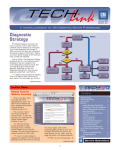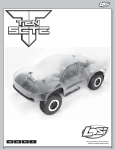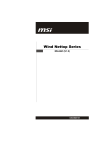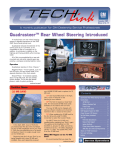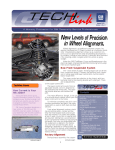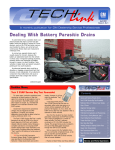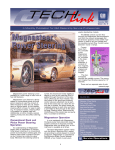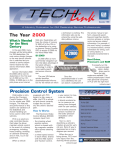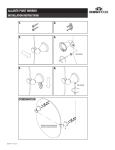Download Dual-Stage Air Bag Debuts Dual
Transcript
October 2000 Volume 2, No. 10 Dual-Stage Air Bag Debuts For the 2001 model year, a supplemental inflatable restraint (SIR) system featuring dual-stage air bags is installed in the Oldsmobile Aurora, Buick LeSabre, Pontiac Bonneville and Chevrolet Impala and Monte Carlo. The dual-stage system was designed to help tailor air bag deployment to the severity of the collision. To help understand how the dualstage system works, let’s review operation of the model year 2000 singlestage system. The air bag inflator module, mounted in the steering wheel or in the instrument panel, consists of a canister of stored gas, an initiator to heat the stored gas to expand its volume, and a fabric bag. In a collision, the initiator is electrically energized. This sets off a chemical reaction which heats the gas and allows the gas to inflate the bag. Once the bag is inflated, it quickly deflates through vent holes and/or the weave of the fabric. An electronic device called the Sensing and Diagnostic Module (SDM) located within the vehicle is wired in series with the initiator. When the SDM detects the conditions indicating that a collision is occurring, it completes the circuit to the initiator. the SDM. For moderate frontal collisions, the stage 1 initiator is energized. For more severe frontal collisions, both stage 1 and 2 initiators are energized together. continued on page 2 Dual-Stage System The dual-stage air bag system adds several enhancements to this basic operation. The dual-stage inflator module contains a canister of stored gas, but has two separate initiators, each controlled individually by the SDM. This means that there are two connectors on the module and two sets of wires between the inflator module and Contents Dual-Stage Air Bag Debuts . . . . . . . . . . . . . . . .1 TIS 2000 Updates Broadcast via Satellite . . . . . .3 Common Diagnostics for Keyless Entry Systems . .3 Trunk Release Handles Now Inside All Trunks . . . .4 New Film Protects Vehicles during Transit . . . . . .4 TAC Tips . . . . . . . . . . . . . . . . . . . . . . . . . . . . .5 Tracker Rear Seat Belt Buckle Positioning . . . . . .5 Finding that EVAP Leak . . . . . . . . . . . . . . . . . . .6 Alero Outside Rearview Mirror Vibration . . . . . . .8 Bulletins . . . . . . . . . . . . . . . . . . . . . . . . . . . . .8 Dual stage airbag is identified by having two electrical connections. 1 Service Operations continued from page 1 deployed dual-stage air bag module as active. Deployment Harness J-38826-75 The SDM also is different. In addition to its internal sensor circuitry, the dual-stage SDM is connected to an additional electronic frontal sensor (EFS) mounted in the area of the grille of the vehicle. The EFS helps judge the severity of the collision and helps the SDM decide whether to ignite just one stage of the inflator module or two. Here’s an important fact. When the inflator module is activated, all of the stored gas is released. If only the first stage initiator is energized, the propellant is heated less, and provides a smaller volume of gas to the bag. If both the first and second stage initia- This means that you cannot dispose of a dual-stage module until you have energized both initiators. The procedure is spelled out in detail in the service manual. It involves use of a special Deployment Harness J-3882675, which has two connectors, one for each initiator. And if you are handling an instrument panel inflator module, you must first attach it to the J-39401-B Deployment Fixture. If you are deploying a dual-stage inflator module with stage 1 already deployed, the movement and noise caused by stage 2 may be reduced, because only the initiator is involved; the stored gas was already used up when the air bag inflated in the collision. Be sure to consult the appropriate service manual sections before performing any service to the dual-stage air bag system. – Chuck Wieseckel contributed to this story. GM TechLink is a monthly magazine for all GM retail technicians and service consultants providing timely information to help increase knowledge about GM products and improve the performance of the service department. This magazine is a companion to the GM Edge publication. VSSM Communications Gracemary Allen Publisher & Editor: Mark Stesney GM Service Operations [email protected] Technical Editors: Mark Spencer [email protected] 1-248-816-3647 Jim Horner [email protected] 1-248-816-3641 Production Manager: Marie Meredith Desktop Publishing: Greg Szpaichler, MediaWurks [email protected] FAX number: 1-248-649-5465 Write to: Sensing and Diagnostic Module (SDM) Connectors of the Deployment Harness J-38826-75 are color-keyed. tors are energized together, the stored gas is heated more and provides a larger volume of gas to the bag. The whole inflation event takes place in mere milliseconds. Deployed Air Bag Service If you are called on to service a vehicle in which a dual-stage air bag has been deployed, you must proceed with caution. Here’s why. Even though the deflated air bag will be hanging from the module, you cannot tell by looking whether only one or both of the initiators were employed. It’s possible that the stage 2 initiator is still active, so you must always treat a Service Information Path 101001001000101 Model Year Make Model Service Manual Restraints SIR - Specifications - Schematic and Routing Diagrams - Component Locator - Diagnostic Information and Procedures - Repair Instructions - Description and Operation - Special Tools and Equipment TechLink PO Box 500 Troy, MI 48007-0500 General Motors service tips are intended for use by professional technicians, not a "do-it-yourselfer." They are written to inform those technicians of conditions that may occur on some vehicles, or to provide information that could assist in the proper service of a vehicle. Properly trained technicians have the equipment, tools, safety instructions and know-how to do a job properly and safely. If a condition is described, do not assume that the bulletin applies to your vehicle or that your vehicle will have that condition. See a General Motors dealer servicing your brand of General Motors vehicle for information on whether your vehicle may benefit from the information. Inclusion in this publication is not necessarily an endorsement of the individual or the company. Copyright© 2000 General Motors Corporation All rights reserved. 2 Return to page 1 Techline News TIS 2000 Updates Broadcast via Satellite TIS 2000 Data CD 17 will be the last CD dealerships receive on a regular basis to update their TIS 2000 applications. After CD 17, TIS 2000 will be Common Diagnostics for Keyless Entry Systems GM uses four different Keyless Entry systems: - Keyless Entry A with a dedicated receiver module that does not communicate with the Body Control Module or the Tech 2 tool. - Keyless Entry C with a dedicated module and Class 2 serial data communicating with the BCM and other modules. - Keyless Entry X with a dedicated module and a keyless entry serial data line communicating with the BCM only. The Keyless Entry Inoperative table in all of the service manuals will start off by verifying the customer’s complaint. You should also read the description and operation of this vehicle’s Keyless Entry system to insure that you are testing the system operation correctly. Next, it will ask you to verify that the customer is using the correct fob for this vehicle. - Keyless Entry UpIntegrated with the receiver integrated into the BCM. updated via broadcasts through the GM ACCESS satellite communications system. With the broadcasts, the TIS 2000 application data, including Service Programming System and the Tech 2, will be updated automatically every two weeks. This will provide dealerships with up-to-date calibration and VIN information while eliminating the need to load TIS 2000 Data CDs to the GM ACCESS file server in the dealership. In order to prepare for the satellite broadcasts, it is important that all GM ACCESS TIS 2000 users load Data CD 17 promptly. The updates that will be broadcast to the GM ACCESS server will build off of the data that is on CD 17. If the dealership’s server is not updated with CD 17, the satellite broadcasts will not be received. Data CD 17 also should be retained for backup purposes. GM also uses a large number of Keyless Entry Transmitters (fobs), depending on platform body styles. A common diagnostic strategy has been developed to save time in diagnosis. This diagnostic strategy will be similar for all Keyless Entry systems and will be tailored for each service manual to the exact vehicle system and wiring for that vehicle line. In multiple vehicle families, your customer may have a fob that looks correct for the vehicle but is different internally and may not work. The wrong fob will pass on the J-43241 Keyless Entry Tester but will not synchronize or program to the vehicle. If you are using the correct fob for this vehicle, the diagnostic then instructs you to test the fob using the J-43241 Keyless Entry Tester to find a dead or weak battery, sticking or inoperative buttons, or a dead transmitter due to internal electronic failure. The next step will instruct you to try to synchronize the fob to the vehicle by pressing and holding both the Lock and Unlock buttons for seven seconds. If synchronization is unsuccessful, the next step is to try to reprogram the fob to the vehicle. If the Keyless Entry system still has a problem, you have either a bad module or a wiring problem. Use the diagnostic procedures as written to help you quickly isolate and repair the condition. A quick reference table (sample shown) will be included in every service manual that allows you to associate the physical appearance of a fob with a part number, the specific vehicle applications, and RPO numbers. – Kemel Kulick When new data is received from the satellite broadcasts, the TIS 2000 application will automatically look for and pull down the updates off of the GM ACCESS server each time the application is opened. The system will display a message that it is updating the TIS 2000 applications. Dealerships that do not run the TIS 2000 applications off of the GM ACCESS system will continue to receive Data CDs on a monthly basis. TIS Data CDs also may be sent out periodically to all users for large data updates and to act as backups for the TIS 2000 data. – Kurt Kilar 3 Return to page 1 Trunk Release Handles Now Inside All Trunks trap resistant latch and, if required, a rear seat tether kit. Beginning with the 2001 model year, all GM passenger cars will now feature new interior trunk release handles as standard equipment. In addition to the new handles, trap resistant trunk kits are available for previous models. And upcoming on several 2001 models, the trunk release TrapAlert™ system will be available. The two systems are designed to help prevent a child from becoming trapped in the trunk. Some type of interior trunk release to help prevent trunk entrapment will become a Federal requirement for all motor vehicles beginning in January, 2001. Trunk Release Handle The new trunk release handle inside the trunk is located on the trunk latch and is easily identified. The handle will glow in the dark following exposure to a light source, making it easier to locate inside the trunk. By simply pulling the release handle, the trunk will open from the inside. It should be pointed out to customers that the trunk release handle is not designed to be used to tie down the trunk lid or as an anchor point Truck release handle now in production The kit’s interior release handle features two LEDs that illuminate when the trunk lid closes. The LEDs remain illuminated for about one hour after the trunk lid is closed. The trap resistant latch in the kit opens the trunk normally but cannot be relatched without the user performing a reset function. This function is a simple operation for an adult, but is difficult for a young child to perform. when securing items in the trunk. Such use of the trunk release handle could damage it and prevent proper operation. The trunk release latch handle is serviced as one component with the rear compartment lid latch assembly. The rear seat tether kit is required if the vehicle is equipped with a pass-through to the rear compartment or a folding rear seat that can be unlatched from within the passenger compartment without the use of a key or other locking feature. The tether kit provides a secondary lock of the seatback. The trap resistant trunk kit also requires a rear trunk lid "ajar" switch. If the vehicle being retrofitted is not equipped with a trunk lid ajar switch, one must be ordered and installed. Coming in a few months, the new automatic TrapAlert™ System will be available. It is designed to open the trunk automatically if the electronic sensor detects motion and a difference of temperature in the trunk. More details about this new system will be coming shortly. – John Force, Jerry Garfield Trap Resistant Trunk Kit For most 1990-2000 passenger cars with trunks, a retrofit trap resistant trunk kit is available. Check bulletin 9908-66-002A for the complete details on the system’s functions, vehicle modifications and part numbers required to install the kit. The trap resistant trunk kit includes three main system components: an LED illuminated interior release handle, a New Film Protects Vehicles during Transit The paint finishes of the Chevrolet Monte Carlo, Camaro and Corvette and the Pontiac Firebird now have additional protection to help maintain their luster. Transseal Temporary Protective Sheet Film (TPF), a non-adhesive "breathable" temporary protective film, is being used to protect the paint finish from mutilation and environmental damage while the vehicle is being transported and when in vehicle storage at the dealership. The Transseal TPF acts as a skin or membrane that allows the paint surface to breathe or out-gas while protecting the finish. It can be used over sheet metal, TPO, RIM, SMC and many other types of painted and molded automotive materials. When it is applied, the TPF film reacts like a shrink-wrap packaging material and conforms to the surface of the vehicle. It’s recommended to leave the film on Retrofit trunk kit the vehicle while it is in dealer inventory until time of delivery to the customer to protect the paint finish. Removing TPF Film TPF film can be removed from the vehicle by using water pressure. With the vehicle in a wash bay area: • Wet the vehicle thoroughly with cold or warm water. Never use hot water to remove the film. The TPF film is designed to remove easily from paint surfaces at ambient temperatures between 60 F and 90 F. • Peel the film off by hand or use water pressure from a garden hose or a pressure washer from a manual car wash system. • It may be efficient to combine the peeling of the film with one hand while directing the water with the other. Place a wire screen over the drain to stop the film from entering the drainage system. The Transseal TPF film is classified as a Class II Non-hazardous Industrial waste and may be disposed of according to local city and state disposal regulations. It also 4 may be recycled back into the plastics industry. The Paint Finish The TPF film is designed to leave the paint finish with a micronized polish. There should be no need to wax or buff the paint finish after removing the TPF film. If a slight haze appears on the paint surface from the TPF film, it can be removed by washing the vehicle by hand with soap and water. If there are any witness marks from the water after removing the TPF film, park the vehicle outside and allow the heat from the sun to warm the paint finish and dry the vehicle. Any TPF film residue also may be removed by using a small amount of the GM "OptiKleen" windshield washing concentrate solution. If any residue remains, general household ammonia may be used. The vehicle should then be thoroughly rinsed with warm water. – Gary McAdam Return to page 1 TAC Tips 2000 Pontiac Grand Prix DTCs Not in Service Information There may be several possible intermittent Vehicle Theft Deterrent (RPO PK3) DTCs (B3022 B3023 B3024 B3025) and/or a crank, no start condition exhibited on some 2000 Pontiac Grand Prix models. Currently, there is no information about these DTCs in the Service Information. These DTCs are B3022, fuel enable circuit range/performance; B3023, fuel enable circuit low; B3024, fuel enable circuit high; and B3025, fuel enable circuit open. When diagnosing these DTCs, keep in mind that this system is not a Class 2 system. The components consist only of the VTD module, the PCM and related wiring. For any of the above DTCs, disconnect the VTD module connector located near the base of the steering column. With the key On, measure the harness side connector CKT 229 for the 5V/12V voltage pull up. If zero volts are measured, check CKT 229 for an open or short to ground. If the circuit checks out OK, check the connec- Tracker Rear Seat Belt Buckle Positioning Each seat belt latch plate in every vehicle is designed to connect only to the matching buckle. This ensures that the seat belts are buckled properly. On 1999-2000 Chevrolet Tracker 4-door models, rear seat passengers may confuse the center and left rear seat belt buckles, which may lead to customer questions and unnecessary parts replacement. tions at the PCM for poor contact or shorts to ground. Replacing the PCM is a possible repair correction only if the circuit and connections are OK. If 5V/12V are measured, check the connection at the VTD module (right where the original disconnect was made) for poor connections or shorts to ground. If the connections are OK, replace the VTD module. The service information will be corrected shortly. Lost AMCOR Wheel Lock Key and Identification Card If the wheel lock key and/or identification card for 1994-2001 Chevrolet Camaro, Corvette and Pontiac Firebird models and 1994-96 Chevrolet Impala models has been lost, a replacement can be obtained in either of following ways: 1. Fill out and send in the registration card with a check for $10 to: AMCOR Wheel Locks 12955 Inkster Rd. Livonia, MI 48150 gray color. Plus, all center rear seat belt service replacement parts for the 1999, 2000 and 2001 model years will be light gray in order to differentiate them from the left and right rear seat belt components. In the rear seat floor pan, the center buckle is located outboard of the left buckle and the center latch plate is located outboard of the right buck- Allow 5-7 days from the receipt of the order. AMCOR will return the I.D. Card with the key. 2. Send a fax with the wheel lock identification number, VISA or MC account number and expiration date, name, ship to address and a daytime phone number with area code to: 734266-6927. There is a $1.50 process fee for faxed orders. Shipping costs are $11.50 for standard shipping and $26.50 for express orders. Customers who have lost their identification card should call AMCOR directly for assistance with finding a GM dealer in their area that has AMCOR master key sets. AMCOR can be reached at 734-4588920, 8:30 a.m. - 4:30 p.m. Eastern time. Regal and Monte Carlo Headliner Sag The interior roof trim panel (headliner) may sag at the rear glass on some 200001 Buick Regals and Chevrolet Monte Carlos due to insufficient adhesive. Add Velcro® or adhesive to resecure the trim panel. Do not replace the trim panel. – GM Technical Assistance le. If the latch plate or buckles are ever removed, they must be reinstalled correctly in order to maintain their effectiveness. For more details and additional graphics illustrating the correct positions of each of the rear seat belt buckles on 1999-2000 Trackers, check out bulletin 99-09-40-002A. – Donald B. Sherman The center rear seat belt buckle on the Tracker is located outboard of the left buckle when the buckles are not in use. When in use, the center and left seat belt buckles cross over each other. To make it easier to identify the rear seat belt buckles, the center buckle is clearly marked "CENTER" on the buckle cover and on the matching center rear latch plate. Beginning with the 2001 model year, the center rear seat belt buckle cover has been changed to a light 5 Return to page 1 Finding that EVAP Leak A leaking Evaporative Emissions (EVAP) system can produce more hydrocarbons in a day than what is emitted from the tailpipe of a properly operating vehicle during the consumption of a complete tank of fuel. Catching those leaks is one of the main reasons behind OBD II. In the past, many leaks were often caused by owners who, for example, did not fully tighten the fuel cap. Now, as those large leaks decrease as owners become more educated about the EVAP system, small leaks pose a greater challenge to technicians. Most small leaks are hard leaks in the system, which cannot be corrected by software calibration changes. Currently, there are no EVAP software issues or new calibrations being developed to address leaks. Repairing EVAP conditions takes an understanding of the EVAP system and the related tools needed to troubleshoot EVAP DTCs. EVAP Basics The EVAP system includes the following components: • fuel tank • EVAP vent valve • fuel pipes and hoses • fuel fill cap • EVAP vapor pipes • EVAP purge pipes • EVAP canister • EVAP canister purge valve From the early 1980s until the advent of OBD II, the system was virtually unchanged. A canister filled with charcoal (or in later years, activated carbon) was designed to absorb and retain hydrocarbon vapors emanating from the fuel tank or the carburetor bowl. A pulse-width-modulated purge solenoid controlled engine vacuum supply to the canister. When the conditions were correct, usually under certain high throttle angles and engine RPM in a closed loop, the ECM would actuate the purge solenoid. The vacuum applied to the canister would pull fresh air into the canister through an integral vent, forcing the hydrocarbons into the intake air charge and burning them in the engine during normal combustion. The fresh air vent on the canister also prevented system overpressure when the vehicle was parked for long periods. The fuel cap also provided an alternate vent path if there was a vent failure of both vacuum and pressure. OBD II When OBD II was introduced, some components were added to the EVAP system to aid the PCM in system diagnostics. The first addition was a vent solenoid, which provided a way to control the vent path in order to test for leaks. Unlike the purge solenoid, it is not pulse-width-modulated. Its valve is normally open to atmospheric air when the solenoid is off. The PCM turns the solenoid on to close the valve when running system tests. Another new OBD II component was the fuel tank pressure sensor. It is typically mounted on or near the fuel tank pump and sender module. This sensor is a threewire strain gage similar in operation and appearance to a manifold absolute pressure (MAP) sensor. However, these parts are not calibrated to the same bias and are not interchangeable. The PCM uses the pressure sensor to detect pressure or vacuum in the fuel system in various tests. In addition, the fuel level sensor provides a direct input for the PCM that is used to determine if the fuel tank level is appropriate for testing (typically 15% to 85%). Fuel caps also changed with OBD II. Venting characteristics under pressure and vacuum were changed to make the caps fall within testing parameters. An aftermarket fuel cap may not conform to these test standards, and may be the cause of a set DTC. Diagnosis and DTCs With all of your diagnosis, begin with the most likely source of leaks, the connections between system lines and components such as the connections at the canister. Also pay close attention to the seam on the filler neck and the o-ring at the fuel tank sending unit. Check for kinked or incorrectly routed vacuum lines as well. Take diagnosis one step at a time and systematically test from one end of the system to the other. Isolate each part of the system. Also check any parts that were removed during other repairs that may have created a leak. When following the diagnostic tables in the service manuals for each EVAP DTC, remember that the tables are based on current conditions. If there is an intermittent leak without a current DTC set, review the "System Description" along with the "Conditions For Setting the DTC" and the "Diagnostic Aids." Many times, EVAP DTCs are not current. But this doesn’t mean they should be cleared immediately. Always try to duplicate the condition. If you can’t, don’t clear the DTCs. They usually will offer some insight into the condition. Reviewing the Fail Records vehicle mileage since the last diagnostic test failed, for example, may indicate how often the condition that caused a DTC to set occurs. If there is a high amount of mileage between failures, chances are there is a very small leak in the system. EVAP System Tests Before the PCM can run the EVAP system tests, certain parameters must be met, such as an appropriate fuel tank level, ambient temperature, coolant temperature, etc. (See the service manual for all parameters). In the EVAP test cycle, the PCM first 6 looks for excess vacuum buildup during normal canister purging. Normal canister purging requires the vent solenoid to be off (open to vent) and the purge solenoid to be on (applying vacuum). Simultaneously, another test run by the PCM during normal purging monitors the oxygen sensors for a fuel trim shift toward rich, indicating sufficient loading of the canister. These tests are the setup for the leak tests. When the PCM determines that the canister was not sufficiently loaded during purge, it will turn on the vent solenoid. A blocked vent path is anticipated to create a vacuum condition in the fuel tank. If it does not, a large leak is detected and DTC P0440 is set or a gross leak is detected and DTC P0446 is set. If the PCM sees the vacuum build in the system, it will turn off the purge solenoid and monitor the fuel tank pressure sensor for vacuum decay or vacuum increase. Vacuum decay indicates a small leak above a calibrated amount, and an increase in vacuum would mean a purge solenoid problem. The testing conditions vary slightly for EVAP systems from vehicle to vehicle, so consult the service manual under "Conditions for Running the DTC" for each set DTC for further clarification of the enable criteria. Using the Tech 2 The Tech 2 is the most powerful and essential tool for EVAP system diagnostics. Under Powertrain Special Functions, the EVAP System menu contains essential outputs for testing the system. The four most common are Purge Solenoid, Vent Solenoid, System Performance and Seal System. Purge Solenoid and Vent Solenoid Tests Purge Solenoid and Vent Solenoid are simply tests that allow you to actuate each solenoid individually. If you are working on a vehicle with a DTC P0446 – EVAP canister vent blocked, for example, what would you do to verify the condition is present? With the vehicle running, activating the Purge Solenoid test should not cause the fuel tank pressure to go excessively into vacuum. If it does, you have verified the presence of the condition and can utilize this test after removing various vent path components to help aid in diagnostics. The Vent Solenoid test can be similarly used to test the purge solenoid. A DTC P1441 – EVAP system flow during nonpurge, can be verified with the vehicle running and by turning on the vent solenoid. Assuming that the purge solenoid is off, the tank pressure should not be decreasing. System Performance Test Using other Tech 2 tests, you can recreate the testing performed by the PCM. Here is another example. On a vehicle with a DTC P0440 – EVAP system large leak detected, your first instinct should not be to tighten the fuel cap, but instead to use the Tech 2. Return to page 1 required to test components and component fittings for a small inaudible leak. Soap should be chosen carefully, as any that contain ammonia may corrode metal parts. Rinse any area tested with soapy water with clean water afterwards. Fuel Cap Adapters If it’s necessary to raise the vehicle, a fuel cap adapter may be used. There are currently four different fuel cap adapters – J-41415-10, -20, -30 and -40 -- that fit the various types of cap designs. From the EVAP System menu, select System Performance. This test will actuate both the purge and the vent solenoids. What’s the anticipated result with the vehicle running? The open purge solenoid and closed vent solenoid should create vacuum in the tank at a level high enough to abort the testing on the Tech 2. If the Tech 2 does not abort the testing at this point, check for a loose fuel cap. If you tighten the cap and then the Tech 2 aborts the test, you have found the source of the DTC P0440. Seal System Test and the EVAP Diagnostic Station The last test found on the Tech 2, Seal System, is used in conjunction with the J41413 EVAP Diagnostic Station. This tool consists of a sturdy green cart outfitted with two gages and a set of hoses. The bottle installed on the cart contains dry nitrogen gas, a non-toxic inert gas (79% of what you are breathing right now is nitrogen) that is safe to use to pressurize the fuel system. An in-line regulator keeps the nitrogen pressure typically less than 30 inches of water pressure (approximately 2 psi). The black hose attached to the cart is for a built-in vacuum gage on the right side of the top panel. The blue hose is designed to go into your shop ventilation system to carry the fumes away from the work area upon system depressurization. The red hose has the service fitting on the end to be attached to the vehicle’s service port for diagnostics. Be sure to check the J-41413 Diagnostic Station for leaks before beginning any diagnostics. Turn on the nitrogen bottle and attach the red service hose to the test port. Next, twist the dial on the face panel to the 9 o’clock position to charge the hose with pressure. Turn the dial to the 12 o’clock position for pressure hold and watch to see if the pressure degrades for a period of a few minutes. If pressure degrades, the diagnostic station needs to be repaired. The theory of testing for leaks is simple. Using the Tech 2 Seal System test, the PCM actuates the vent solenoid and prevents the actuation of the purge solenoid to prepare the system for pressure testing. Pressure is used rather than vacuum to aid in locating the leak. Pressure leaks are outwardly audible or may be detected with a soapy water solution. Snoop Liquid Leak Detect from Kent-Moore, J-41365, or equivalent may be used. Using the diagnostic station, apply a small amount of pressure (typically 5 to 7 inches of water column pressure). This is a process that can vary in time depending on the amount of fuel in the tank. If the system does not pressurize, locate the leak using the J-41416 Ultrasonic Leak Detector and repair immediately. The pressure apply may be modulated by turning the dial on the Diagnostic Station toward the 9 o’clock position from the 12 o’clock position. Watch the fuel tank pressure reading on the Tech 2 to see if it is approaching the pressure gage reading on the left side of the J-41413 panel. After flow is stopped, pressure readings will stabilize within a few seconds. Add more pressure as necessary to reach the desired testing level. The next step is to watch for any decay of pressure. The general area of a rapid pressure loss typically may be located with the ultrasonic leak detector. This device is sensitive to specific sounds associated with air leaks. Be careful to use this tool in an area that is free of other sources for air noise, such as leaky shop lines or fittings, air tools, spray cans, etc. Soapy Water Testing Leaks associated with DTC P0442 – EVAP small leak, may require a different approach. Once pressure decay is verified, a trigger bottle of soapy water may be 7 Fuel cap adapters have become necessary in testing for one other reason. With the advent of ORVR (On-board Refueling Vapor Recovery), the fuel tank and filler neck architecture have changed. No longer is there a vent tube running parallel to the filler tube. The filler tube is now much smaller to provide a seal preventing the loss of hydrocarbons during fill. The fuel vapors are sucked down the neck by a venturi effect created by the rushing fuel and collected by the EVAP Canister. Also integrated in the filler design is an anti-spitback check valve in the base of the filler neck at the tank. During pressurized system leak tests using the vehicle’s underhood service port, testing pressure may never make it to the filler neck due to the level of fuel in the tank and the anti-spitback valve. The valve creates a positive seal under pressure, whereas under vacuum (the way it is tested by the PCM) the valve allows for ventilation of the system and testing fails. Therefore, a technician not using a fuel cap adapter (typically, adapter J-41415-40 is used on ORVR systems) may never see a pressure decay if the leak is in the filler neck or fuel cap. Testing with the Diagnostic Station through a fuel cap adapter can help to find these leaks. Confirming Repairs Once the leak is found and repaired, another noteworthy Tech 2 feature under Powertrain Special Functions is Service Bay Tests – EVAP System. This test function helps the PCM run the diagnostics for the various EVAP system DTCs more quickly, broadening the enable criteria for purposes of verifying the repair of the vehicle. This is a critical step in preventing an EVAP related comeback. Keep in mind that two consecutive passes are needed when confirming a repair. If it passes once in the service department, it may not pass again in the owner’s driveway. As with all repairs, checks should be made for any applicable bulletins and calibrations that address EVAP conditions. Presently, however, there are not any new calibrations being developed for current EVAP systems. EVAP system leaks can be hard to find. But if you know what causes each DTC to set, and understand how to use the tools available to you, you’ll be well on your way to expertly diagnosing EVAP conditions. – Craig Blake Return to page 1 Bulletins – September 2000 This review of service bulletins released through mid-September lists the bulletin number, superseded bulletin number (if applicable), subject and models. GENERAL INFORMATION: 00-00-89-018; July, 2000 Bulletin Summary; 2001 and Prior Passenger Cars and Trucks 00-00-89-019; New Electrical Relay Labor Operation Numbers; 2001 and Prior Passenger Cars and Trucks 00-00-89-020; September, 2000 Labor Time Guide Updates; 1996-2001 Passenger Cars and Trucks 00-00-89-021; Cross-line Warranty; 2001 and Prior Passenger Cars and Trucks HVAC: 99-01-39-006A; Replaces 99-01-39-006; Production Changes to A/C System Components, Revisions to Reduce Possible Passenger Compartment Hiss Noise and New Charging Guidelines; 1999 Chevrolet Corvette 00-01-37-003; Delphi®-Harrison and Denso A/C Compressor Usage; 2000-2001 Chevrolet and GMC C/K Pickup Models With 4.8L, 5.3L or 6.0L Gen III Gas Engine (VINs V, T, U – RPOs LR4, LM7, LQ4) 00-01-38-006; Essential Tool J 43600 ACR 2000; 1993-2001 Passenger Cars and Trucks (Except Medium Duty Trucks) SUSPENSION: 00-03-10-003; Replaces 60-05-02; General Motors Tire Warranty; 1996-2001 Passenger Cars and Light Duty Trucks (Except Saturn Models) BRAKES: 00-05-22-007; Reduced Brake Pad/Lining Life (Install New Brake Booster Pushrod Lever); 1997-98 Chevrolet and GMC T-Series Medium Duty Tilt Cab Models With Hydraulic Brakes (RPO JE3) Built Prior to January 28, 1998 00-05-23-005; Availability of Rear Wheel Mud Flaps; 1999-2000 Chevrolet and GMC C/K Pickup Models (Silverado and Sierra) ENGINE/PROPULSION SYSTEM: 00-06-01-016; Enhanced Aluminum Engine Component Thread Repair Process; 1993 Cadillac Allante, 1993-2001 Cadillac Eldorado and Seville, 1994-1999 Cadillac DeVille Concours, 1996-2001 Cadillac DeVille, 2000-2001 Cadillac DeVille Touring, 1997-2001 Chevrolet Corvette, 1998-2001 Chevrolet Camaro, 1995-2001 Oldsmobile Aurora (V8), 1999-2001 Oldsmobile Intrigue, 2001 Oldsmobile Aurora (V6), 19982001 Pontiac Firebird, With 2.2L, 3.5L, 4.0L, 4.6L or 5.7L Engine (VINs F, H, C, 9, Y, G, S – RPOs L61, LX5, L 47, L37, LD8, LS1, LS6) 00-06-01-018; Growl/Moan Noise During Sharp Left Turn (Modify Engine Mount Stamping): 2000 Chevrolet Cavalier, 2000 Pontiac Sunfire, With 2.2L Engine (VIN 4 – RPO LN2) 00-06-02-006; Replaces 73-62-14; DEXCOOL® Engine Coolant Information; 2001 and Prior Passenger Cars and Trucks 00-06-04-025A; Replaces 00-06-04-025; ABS Light On at High Speeds (Above 70 mph or 113 km/h), Code C0237 Set (Install New PCM); 2000 Chevrolet and GMC S/T Pickup Models With 2.2L Engine (VINs 4, 5 – RPOs LN2, L43) and 4L60-E Automatic Transmission (RPO M30) 00-06-04-028; Bang/Slosh From Rear of Vehicle (Install Fuel Tank Insulators); 2000 Buick Century and Regal, 2000 Chevrolet Impala and Monte Carlo 00-06-04-030; Revised Fuel Pressure Operating Range; 2001 Buick LeSabre, Park Avenue and Regal, 2001 Chevrolet Impala and Monte Carlo, 2001 Pontiac Bonneville and Grand Prix, With 3.8L Engine (VIN K – RPO L36) 00-06-04-033; Enhanced Emission Inspection Maintenance Program – Emissions Diagnostic Manual for OBD II Vehicles; 19962000 Passenger Cars and Trucks 00-06-04-037; Service Engine Soon (SES) Light On With DTCs P0716 and/or P0717 Set (Repair Input Speed Sensor Wiring at Transaxle Wiring Pass-thru Connector); 2000-2001 Chevrolet Cavalier and Malibu, 2000-2001 Oldsmobile Alero, 2000-2001 Pontiac Grand Am and Sunfire, 2000 Toyota Cavalier 00-06-04-038; Unwanted Switch to Gasoline, Fuel Indicator Lamp (FIL) Inoperative, Cooling Fan Inoperative, Engine Running Hot and/or Overheating (Replace Cooling Fan/CNG Fuse); 2000 Chevrolet Cavalier With 2.2L Engine (VIN 4 – RPO LN2) and Bi-Fuel (CNG) (RPO KL6) TRANSMISSION/TRANSAXLE: 00-07-29-001; 4-3 Downshift Gear Clash, 1-2 Upshift Gear Clash When Cold (Replace Affected Gear, Synchronizer Ring, Synchronizer Assembly and Transmission Fluid); 1999-2000 Chevrolet Tracker With 5-Speed Manual Transmission (RPO M59) 00-07-30-002A; Replaces 00-07-30-002; Slips, Harsh Upshift or Garage Shifts, Launch Shudders, Flares, Erratic Shifts and Intermittent Concerns, DTC P1811 or P0748 Set (Replace Pressure Control Solenoid Valve Assembly); 1999-2000 Buick LeSabre, Park Avenue/Ultra, Regal and Riviera, 1999 Chevrolet Lumina, Monte Carlo and Venture, 1999 Oldsmobile Eighty-Eight, Intrigue and Silhouette, 1999 Pontiac Bonneville, Grand Prix and Montana, With Hydra-Matic 4T65-E (RPO MN3, MN7 or M15) and 3.4L, 3.5L or 3.8L Engine (VINs E, H, K, 1 – RPOs LA1, LX5, L36, L67) 00-07-30-015; Revised DTC Tables for P0716 and P0717 (Section 7 Automatic Transmission); 1998-2000 Chevrolet and GMC C/K Models and G Van With Hydra-Matic 4L80-E Automatic Transmission (RPO MT1) 00-07-30-016; Removal of the PWM Filter From the Spacer Plate – 4T40E/4T45E Automatic Transmission; 1998-2000 Chevrolet Cavalier and Malibu, 1998-1999 Oldsmobile Cutlass, 19992000 Oldsmobile Alero, 1998-2000 Pontiac Sunfire, 1999-2000 Pontiac Grand Am, With 4T40E or 4T45E Automatic Transmission (RPOs MN4, MN5) 00-07-31-001; Clutch Noisy, Slipping or Inoperative (Replace Clutch Release Bearing); 1990-2000 Chevrolet and GMC C6-7 Conventional Medium Duty Trucks, 1993-2000 Chevrolet and GMC B7 School Buses, With Gas or Diesel Engine and Spicer 310 mm Clutch (RPO MRJ), Valeo 13 Inch Clutch (RPO MPJ), or Midland Lipe Clutch Built Prior to May 24, 2000 and VIN Breakpoints BODY AND ACCESSORIES: 99-08-48-001A; Replaces 99-08-48-001; Wind Noise from Body Side Quarter Window (Replace Body Side Quarter Window Assembly); 1999-2000 Chevrolet and GMC C/K Extended 8 Cab Pickup Models (Silverado and Sierra) Built Prior to February 1, 2000 00-08-49-009; Addition of DTC B2961 Diagnostics; 2000 Chevrolet and GMC C/K Pickup and Utility Models, 2000 Chevrolet S/T Models and M/L Vans, 2000 Oldsmobile Bravada 00-08-51-001; Outside Rear View Mirror Housing Turns Chalky/Dull (Color/Clear Coat Mirror); 1998-2000 Buick Century, Park Avenue and Regal, 1998-2000 Chevrolet Cavalier, Lumina, Malibu, Metro, Monte Carlo, Prizm, Tracker and Venture, 2000 Chevrolet Impala, 1998-2000 Oldsmobile Intrigue and Silhouette, 1999-2000 Oldsmobile Alero, 1998-2000 Pontiac Bonneville, Grand Am, Sunfire and Trans Sport, 1998-2000 Chevrolet and GMC C/K, S/T Models and M/L Van, 1998-2000 Oldsmobile Bravada 00-08-52-004; Intermittent Operation of Remote Keyless Entry System (Replace Instrument Panel Cluster); 2000 Chevrolet Impala and Monte Carlo 00-08-61-002; Engine Mount Crossmember Cracking (Replace Crossmember and Fasteners); 1993-2000 Chevrolet and GMC B6-7 Medium Duty School Bus Models With 3116/3126 Caterpillar® Diesel Engine 00-08-62-002; Brush Guard Removal; 1999 Chevrolet Tahoe Utility Models With Off-Road Chassis Package (RPO Z71) Alero Outside Rearview Mirror Vibration The outside rearview mirror on some 1999-2001 Oldsmobile Alero models may vibrate at all speeds. There also may be excessive wind noise coming from the "A" pillar area of the vehicle. The vibration and windnoise may be caused by the breakaway mirror not being properly seated at the mirror patch. Cycle the mirror housing forward and rearward to allow the mirror to snap back. Observe the mirror housing. It should be flush to the mirror patch and fully seated around the circumference. In addition, the mirror glass retainer may not be fully seated into the power mirror motor assembly, or into the retainer on manual mirrors. Press the center area of the reflective surface to ensure that the mirror glass retainer is fully seated (snaps in place) in the power mirror motor, or in the mirror retainer on manu al mirrors. – Darryl Butler Return to page 1








